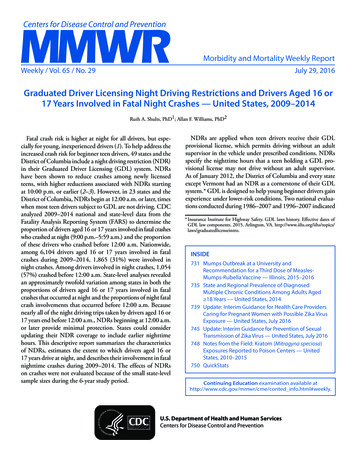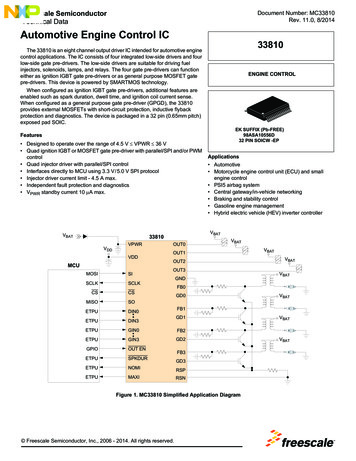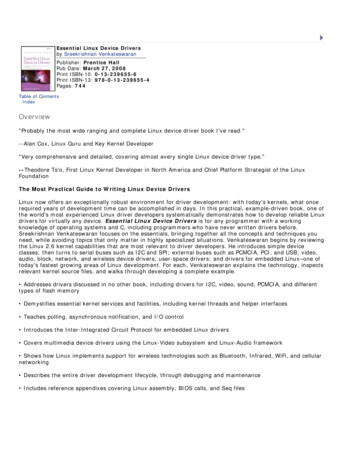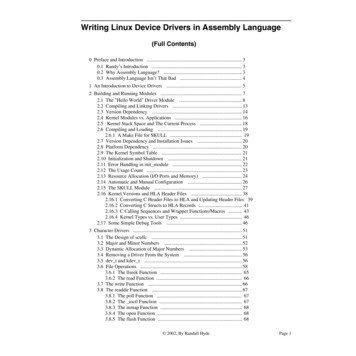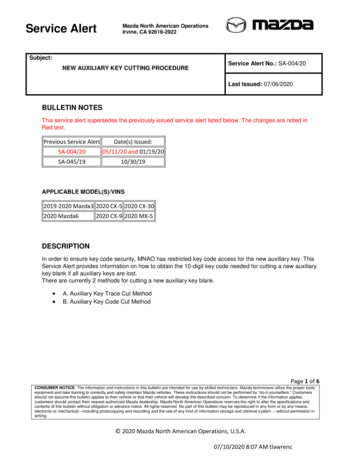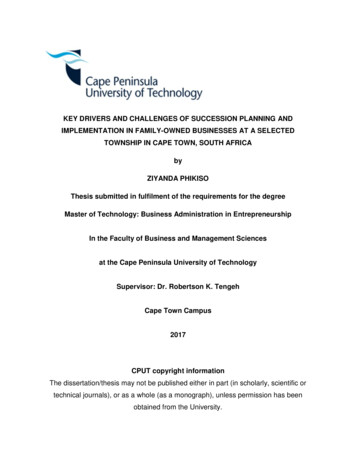
Transcription
KEY DRIVERS AND CHALLENGES OF SUCCESSION PLANNING ANDIMPLEMENTATION IN FAMILY-OWNED BUSINESSES AT A SELECTEDTOWNSHIP IN CAPE TOWN, SOUTH AFRICAbyZIYANDA PHIKISOThesis submitted in fulfilment of the requirements for the degreeMaster of Technology: Business Administration in EntrepreneurshipIn the Faculty of Business and Management Sciencesat the Cape Peninsula University of TechnologySupervisor: Dr. Robertson K. TengehCape Town Campus2017CPUT copyright informationThe dissertation/thesis may not be published either in part (in scholarly, scientific ortechnical journals), or as a whole (as a monograph), unless permission has beenobtained from the University.
DECLARATIONI, Ziyanda Phikiso, declare that the contents of this thesis represent my own unaidedwork, and that it has not previously been submitted for academic examination towardsany qualification. Furthermore, it represents my own opinions and not necessarily thoseof the Cape Peninsula University of Technology.SignedDateiii
ABSTRACTFamily-owned businesses have long played a significant role in the economies of thedeveloped countries and are rapidly becoming an equally dominant force in those ofdeveloping countries. Family businesses are also recognised as a potential driver ofeconomic growth and the creation of wealth throughout the world. The significantcontribution which family businesses have been making to the South African economyover the last 300 years is made evident by the fact that approximately 80% ofbusinesses in South Africa could be classified as family businesses and the equallycompelling fact that they comprised of the order of 60% of the companies which werelisted on the (JSE) Johannesburg Stock Exchange during its infancy.The main objective of the study was to determine the drivers of planning for successionin family-owned businesses in the township of Gugulethu in Cape Town in South Africa.The study also undertook to investigate the challenges which family-owned businessesencounter as they endeavour to transfer ownership and control from one generation tothe next. The fact that although family-owned businesses contribute significantly to theeconomy, very often they do not survive a generational transition provides amplejustification for undertaking to determine the factors which contribute to successfulsuccessions. This research study took the form of a real-time, longitudinal study inwhich the researcher could experience how the succession process unfolds in thefamily-owned businesses of the respondents and participants who made up theresearch sample.The study made use of a mixed methods approach to collect and analyse the data. Inthe quantitative study, questionnaires were administered to 120 owners and managersof family-owned businesses, while the qualitative data were obtained from in-depthinterviews with owners and managers. The quantitative data were analysed using theStatistical Package for the Social Sciences (SPSS) software, while the data which wereobtained from the face-to-face interviews were analysed by means of thematic analysis.iv
The results which were obtained from the quantitative study were presented in tabulatedformat.The findings of this research study revealed that many owners and managers of thefamily-owned businesses did not involve members of their families in the making ofdecisions concerning the running of their businesses. It was found that a lack of mutualtrust and cooperation was one of the main factors which militated against successfulplanning for succession in the businesses. In addition, problems pertaining to planningfor succession were often further aggravated by a lack of clear objectives with respectto planning for succession or not providing successors with the training which is neededto manage the businesses effectively. A significant finding with respect to planning forsuccession was that family-owned businesses do not necessarily have formally writtendown plans for succession which they follow and that, instead, culture and social normsplay a significant role in determining potential successors or owners of the businesses.It was also found that so far relatively little attention has been given to succession infamily-owned businesses, particularly insmall to medium-sized family-ownedbusinesses in areas which are plagued by high levels of crime, such as Gugulethu.v
ACKNOWLEDGEMENTS I wish to thank the Lord Almighty for giving me the wisdom and courage toundertake this journey. I express my sincere gratitude to my supervisor, Dr. Robertson K. Tengeh, forcontinuously reading my work. His special interest and knowledge of this fieldenabled him to provide me with the guidance and motivation which I needed tocomplete this thesis. Special thanks also go to the Head of Department, Prof. Chux Iwu, for providingme with the opportunity to pursue a master’s degree. Miss Leticia MbuthokaziToli and Justino Mateus for undertaking this journey with me, I appreciate you. I am grateful for the financial assistance which I received from the NationalResearch Foundation (NRF) towards this research; the funding was administeredby the Postgraduate Research Centre of the Cape Peninsula University ofTechnology. My sincere appreciation goes to my mother, Mrs Nomlungisi Phikiso, and my latefather, Mr. Mongezi Zebron Phikiso, for their unconditional love and for teachingme the value of education. I wish to thank my siblings, Thozama, Zininzi, Sixolisiwe and my late sister, ZinePhikiso for their support, encouragement and concern. This achievement will alsobe an inspiration to you, my wonderful sisters: in life, there is nothing that youcannot achieve. Thanks also go to my Godmother, Mrs. N.N. Mdibi, and my mother’s church,“Ibandla Likayesu”, for their constant prayers. I wish to give very special thanks to Mr. Thapelo Jacob Seatlhodi, my bestfriend/partner and Mr. Justice Baruti, for their remarkable encouragement andvi
support during times when I was tempted to give up. I will forever cherish andappreciate you both. Finally, I wish to thank my grandmother, Mrs. Vinah Nombhedesho Madikizela, forinstilling in me the importance of education from a very young age: “Enkosimakhulu wam, anga uThixo angakusikelela”. To my aunts, Nomalungisa,Nonkuselo and Nongcaciso, my cousins Zimaseka, Ntombizolile, Afike, Khwezi,Anovuyo and Bomikazi, I did this work for all of you.vii
DEDICATIONThis thesis is dedicated to my mother, Nomlungisi Phikiso and my three sisters,Thozama, Zininzi and Sixolisiwe.viii
TABLE OF CONTENTSDECLARATION . iiiABSTRACT . ivACKNOWLEDGEMENTS . viDEDICATION . viiiCHAPTER 1 . 1INTRODUCTION AND BACKGROUND TO THE STUDY . 11.1 Introduction . 11.2 Background to the research problem . 21.3 Problem statement . 41.4 Research questions . 51.4.1 Main research question . 51.4.2 Research sub-questions . 51.5 Objectives of the research . 51.5.1 Primary objective . 51.5.2 Secondary objectives . 51.6 Research methodology . 61.6.1 Approach to the research and research methods . 61.7 Research design . 71.8 Population . 71.8.1 Research sample . 71.8.2 Sampling techniques . 81.9 Techniques employed to collect data . 81.9.1 Personal interviews . 8ix
1.9.2 Questionnaires. 91.10 Analysis and interpretation of the data . 91.10.1 Reliability and validity . 91.11 Significance of the study . 101.12 Anticipated effects, results and contributions of the research study . 101.13 Ethical considerations . 111.14 Structure of the thesis . 111.15 Summary. 13CHAPTER 2 . 14LITERATURE REVIEW . 142.1 Introduction . 142.2 Business history . 142.3 Definition of a family-owned business . 152.3.1 Unique characteristics of family-owned businesses. 152.3.2 Family businesses are distinguished by some of the following characteristics:. 162.4 Planning for succession . 172.4.1 The management of human resources . 172.4.2 A critique of the relevant available literature . 182.5 Planning for succession in family-owned businesses . 192.6 The process of planning for succession . 202.7 Drivers for the planning of succession . 212.8 Planning for succession . 212.8.1 The process of planning for succession and family-owned businesses . 222.9 Theoretical frameworks for succession . 23x
2.9.1 Conceptual model and determinants of satisfaction in the succession process. 242.10 Disadvantages of working in family businesses . 282.11 Summary. 29CHAPTER 3 . 30RESEARCH DESIGN AND METHODOLOGY . 303.1 Introduction . 303.2 Research methods . 303.3 Research design and methodology . 323.4 Delineation of the research . 323.5 Target population . 323.5.1 Research sample . 323.5.2 Unit of analysis . 333.5.3 Methods employed to collect data . 343.5.4 Primary and secondary data . 343.5.5 Questionnaires. 343.5.6 Analysis and interpretation of the data . 353.5.7 Reliability and Validity . 353.5.8 Ethical considerations . 363.6 Summary. 38CHAPTER 4 . 39PRESENTATION AND DISCUSSION OF THE FINDINGS . 394.1 Introduction . 394.2 Revisiting the objectives of the study . 394.3 Analysis of the results of the study . 39xi
4.4 Presentation and analysis of the quantitative data . 404.4.1 Section A: Demographic backgrounds of the owners or managers of familyowned businesses who responded to the questionnaire . 404.4.2 Section B: Business profile . 454.4.3 SECTION C: Desirable characteristics of a potential successor in a familyowned business . 494.4.4 SECTION D: The importance which is accorded to drivers of planning forsuccession . 574.4.5 SECTION E: Challenges which are encountered during planning forsuccession in family-owned businesses . 634.5 Summary of the quantitative study . 734.6 Qualitative data presentation and analysis. 744.6.1 Analysis of interviews . 744.6.2 Summary of qualitative data . 794.6.3 Factors which could affect the survival of family-owned businesses . 80CHAPTER 5 . 81CONCLUSIONS AND RECOMMENDATIONS . 815.1 Introduction . 815.1.1 A summary of the preceding chapters . 815.1.2 Chapter 1 . 815.1.3 Chapter 2 . 825.1.4 Chapter 3 . 825.1.5 Chapter 4 . 825.1.6 Chapter 5 . 825.2 Principal findings of the study . 825.3 Recommendations . 83xii
5.4 Limitations of the study . 835.5 Recommendations for future research . 845.6 Conclusion . 85REFERENCES . 86APPENDICES . 96Appendix A: Approval letter from Gugulethu Municipality . 96Appendix B: Ethical clearance . 97Appendix C: Consent letter to participants . 98Appendix D: Questionnaire for Owners/Managers . 99Appendix E: Interview Guide . 106Appendix F: Grammarian Certificate . 108LIST OF FIGURESFIGURE 1: Determinants of satisfaction with the succession process in the family firmLIST OF TABLESTable 4.1: Owner or ManagerTable 4.2: Genders of the respondentsTable 4.3: AgeTable 4.4: Highest educational qualificationTable 4.5: The ethnic backgrounds of the familiesTable 4.6: Types of business entitiesTable 4.7: Types of businesses operated by the respondentsTable 4.8: Numbers of members of families who work full time in the businessesxiii
Table 4.9: Numbers of years for which the businesses have operated as familybusinessesTable 4.10: Percentages of the businesses which were controlled by the families whoowned themTable 4.11: A potential successor should have good business management skillsTable 4.12: A potential successor should be capable of maintaining leadershipTable 4.13: A potential successor should have good relationships with the members ofthe familyTable 4.14: A candidate should show interest in becoming a successorTable 4.15: A candidate should possess greater aptitude than other members of thefamilyTable 4.16: A potential successor should be a member of the family who possessesvision concerning the future of the businessTable 4.17: A successor should be competentTable 4.18: A potential successor should be a trustworthy personTable 4.19: The successor should show commitment to the businessTable 4.20 A potential successor should have sufficient experience in the managementof a businessTable 4.21: A potential successor should be one of the children of the ownerTable 4.22: A potential successor should be able to balance the interests of the familywith those of the businessTable 4.23: The importance of formulating a plan for succession for family businessesTable 4.24: Having a properly formulated succession plan would ensure that a familybusiness is able to survive should it lose its owner or managerTable 4.25: A properly formulated and clearly articulated plan for succession wouldensure the continuation of strong leadershipTable 4.26: The existence of a coherent plan for succession would ensure that thepresent management of the business had sufficient time to review and examine itsgoals and objectivesxiv
Table 4.27: The existence of a plan for succession would help to maintain goodrelationships among the members of the family and enable them to give sufficientpriority to the interests of the businessTable 4.28: Relationships among the members of my family have been good since Itook over the management or leadership of the family businessTable 4.29: It is difficult to discuss potential successors with members of the familyTable 4.30: The inability of families to identify the future needs of their organisationswith respect to talentTable 4.31: An inability to locate or create a pool of potential candidates in the businessTable 4.32: A lack of interest on the part of the members of the familyTable 4.33: Conflicts among members of the familyTable 4.34: The ownership of a family business should remain in the familyTable 4.35: The degrees of involvement in the decision-making process of the membersof the familyTable 4.36 Identification of the next business leaderTable 4.37 The availability of a potential successorTable 4.38: The potential of wrangles within the family to threaten the survival of familybusinessesTable 4.39 Business obstaclesTable 4.40: Succession and continuityxv
CLARIFICATION OF CONCEPTS AND TERMSRSARepublic of South AfricaFOBsFamily-owned businessesUSAUnited States of AmericaGDPGross domestic productICTInformation and communication technologySMEsSmall and Medium EnterprisesJSEJohannesburg Stock ExchangeNRFNational Research FoundationDTIDepartment of trade and industrySTPSeda Technology programmeSASouth AfricaSMEsSmall and Medium EnterprisesSPSSStatistical Package for the Social SciencesHDCHigh Degree CommitteeJSEJohannesburg stock ExchangeKEY WORDS:Succession planning, succession, family-owned businessxvi
CHAPTER 1INTRODUCTION AND BACKGROUND TO THE STUDY1.1 IntroductionFamily-owned businesses are becoming increasingly recognised as significant driversof economies in both developed and developing countries. Several researchers haveasserted that throughout the world, family-owned businesses (FOBs) make significantcontributions towards social development, the creation of employment, the promoting ofeconomic wealth and reducing poverty (Hjorth, 2016:3; Visser & Chiloane-Tsoka, 2014,Byrd & Megginson, 2013:24; Lind, 2012; Chittoor & Das, 2007:12).FOBs account for approximately 90% of all businesses in the world and play significantroles in advanced and emerging economies alike (Hjorth, 2016:3; Gedajlovic, Carney,Chrisman & Kellermanns, 2012:25). According to the Family Firm Institute (2014), FOBsaccount for 80% of all firms in the United States of America (USA) and are responsiblefor approximately 50% of the gross domestic product (GDP) of the country. In SouthAfrica, FOBs account for 50% of the economic growth which takes place (Fishman,2009:56). It is also estimated that families are involved in the ownership andmanagement of more than 80% of all South African businesses and that more than 60%of all companies which were listed on the Johannesburg Stock Exchange (JSE) duringthe stage of its infancy had been family-owned (Van Buuren, 2007:65).The rapid growth of FOBs in South Africa can be attributed to the government havingembarked on several initiatives to support small and medium-sized enterprises (SMEs)(Hjorth, 2016:10). These initiatives include the Small Enterprise Development Agency(SEDA), the Department of Trade and Industry (DTI) and the Seda TechnologyProgramme (STP) (Ndabeni, 2008). The South African government recognisesentrepreneurial activity as a means of stimulating the economy of the country,encouraging growth and responding to the increasing inability of the informal sector tocreate new opportunities for employment (Visser & Chiloane-Tsoka, 2014).1
However, the contribution which FOBs make to socio-economic growth has not beenadequately explained or understood in South Africa and, consequently, little is known ofthe conditions which are necessary for successful FOBs (Maas, 2014). Although thenature of FOBs and the vital role which they play in the economy may not have receivedadequate attention in the general management literature, it is indisputably of crucialimportance for any individual person, team or organisation working in the domain ofFOBs to plan effectively for the future (Jacobs, 2006).Typical areas of concern for FOBs include succession, insularity, interpersonal conflictsand conflicts of interest within the families concerned and governance (Visser &Chiloane-Tsoka, 2014). Additional problem areas include relationships within thefamilies, intergenerational changes, and the sustainability of family-owned businesses(Visser & Chiloane-Tsoka, 2014; Nordqvist and Melin, 2010). FOBs typically strugglewith succession planning, conflicting value systems, and inter-generational tensions(Hjorth, 2016:22). These areas of conflict are a cause for concern with respect to thecommon lack of longevity among FOBs. Owing to the role which they play in both theeconomy and the socio-economic development of South Africa, the survival of FOBsfrom one generation to the next is of crucial importance to the economic growth of thecountry.1.2 Background to the research problemThe businesses and institutions which last do not generally result from the narrowpursuit of popularity or personal advancement, but rather of devotion to a greaterpurpose, namely, the desire to leave a worthwhile achievement for the next generation,the commitment to give back to the community in which a business enterprise hasprospered and a determination to boost the economy (PricewaterhouseCoopers, 2008:53).2
The relevant available literature concerning FOBs is frequently characterised byaccounts of problems and pitfalls, with their lack of longevity being a principal cause forconcern (Glu, Kula & Glaist, 2008: 155). The smaller FOBs are particularly vulnerable,with many surviving for between five to ten years and their average life span being amere 24 years (Stavrou & Swiercz, 1998; Venter & Boshoff, 2005: 283). According toseveral researchers and writers, one of the main reasons, if not the single mostsignificant reason, for the failure of FOBs to survive is intergenerational succession withrespect to management (Hjorth, 2016:22; Venter, Van der Merwe & Farrington, 2012;Venter, Boshoff, & Maas, 2005, Visser & Chiloane-Tsoka, 2014).One of the most challenging tasks which faces FOBs is planning for succession.Evidence indicates that only approximately 30% of the FOBs make the transition to thesecond generation, while only 12% make it to the third, with a mere 3% making it to thefourth generation and beyond, with the remaining 97% being either sold or liquidatedduring the attrition which accounts for the vast majority (Byrd & Megginson, 2013;Chittoor & Das, 2007). This state of affairs generates interesting research questionsconcerning the dynamics of successful successions. There can be little doubt that thesuccessful planning of successions holds the key to the long-term survival of FOBs.If the planning of successions in FOBs is not carried out properly, the prospects forsurvival from the first to future generations are likely to be severely, if not fatally,compromised. As a direct consequence, the degree to which the South Africaneconomy benefits from the considerable contribution which is made by FOBs becomesequally likely to be drastically reduced. It was on the basis of these considerations thatthe researcher elected to conduct a research study of planning for succession amongFOBs in South Africa.3
1.3 Problem statementThe longevity of family-owned organisations depends on the strengths of therelationships which exist among members of families upon whose skills and experiencethe organisations depend. Whether they act as representatives or proprietors, theirdedication and motivation are crucial for the achieving of congruity in privately-runcompanies. As many researchers who have conducted studies of family-ownedbusinesses have pointed out, intergenerational mobility is a key factor for theirprospects of survival. In this respect, responsibility among the members of the familiesconstitutes one of the key components which ensure viable and smooth succession infamily-owned businesses (Bjornberg, Nicholson, 2012).A review which was conducted by PricewaterhouseCoopers (2008: 26) revealed that25% of the organisations which were included in the review were likely to change handswithin the next five years. It was also found that 51% of the respondents whoanticipated changes in terms of responsibility for their organisations believed that itwould remain in their families and that approximately half of all the organisations whichwere reviewed had no formally articulated strategies for succession.This study has endeavoured to investigate the key drivers and c
planning for succession in the businesses. In addition, problems pertaining to planning for succession were often further aggravated by a lack of clear objectives with respect to planning for succession or not providing successors with the training which is needed to manage the businesses effectively.
